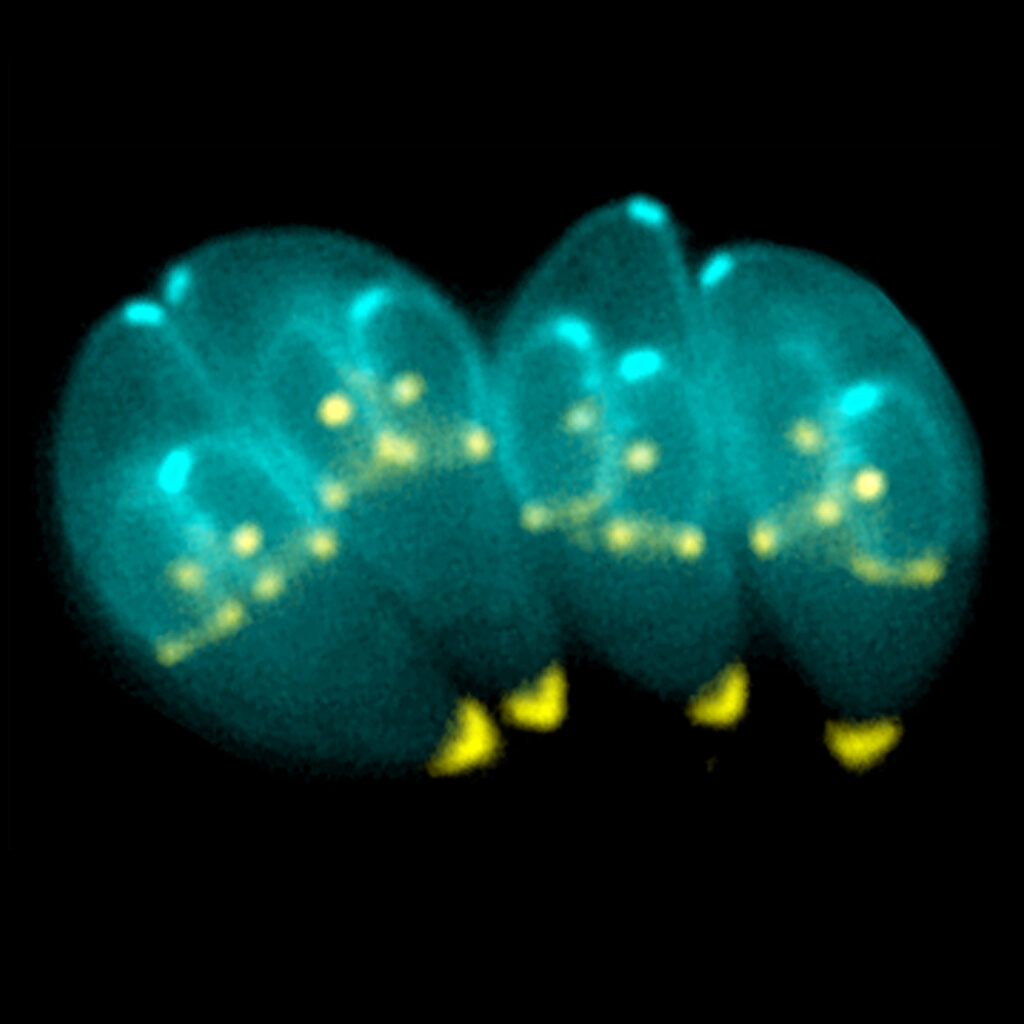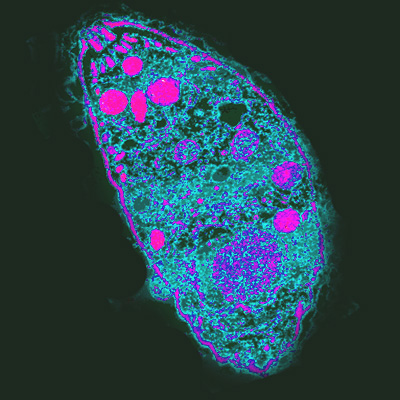This webpage was produced for an undergraduate course at Davidson College.
Toxoplasma gondii, a parasite that can infect humans, is more often referred to as “toxoplasmosis” and is often passed through either cat feces or contaminated food. The parasite usually attacks immunocompromised individuals, and its symptoms include fevers, headaches, and muscle stiffness and fatigue (CDC). It cannot be passed person-to-person, other than from mother to fetus, and the CDC estimates that 11% of Americans over the age of six have been infected with this parasite at some point in their lifetime. While the parasite rarely causes death, it can produce complications during pregnancy and is one of the least well-known parasitic diseases in America (CDC). This protozoan (a group of often parasitic bacterium that includes giardia and amoebas) has only been studied in any depth during the last twenty years, so studies that explore interactions between the parasite and its host provide critical information about the spread and progression of disease and are essential to developing effective treatment methods.
A recent paper on T. gondii revealed important information on the interactions between T. gondii proteins and host mitochondria (Blank et. al., 2021). Prior to this paper, it was known that there were interactions between the parasite and host mitochondria, but the nature and significance, as well as the specific proteins involved in those interactions, remained unknown. Blank et. al. were able to shed light on some of the organelle-parasite interactions between T. gondii and its host cell. Organelles—the specialized structures within a cell that include the mitochondria, endoplasmic reticulum, and nucleus, among others—can serve as important interaction points for viral and bacterial diseases that exploit the organelles’ protein synthesis mechanics to proliferate their own genomes. It is important to note, however, that this study was narrow in scope and focused on a small number of significant proteins in the mitochondria; it is still possible that there are other mitochondrial proteins that may play a role in the infection and proliferation of T. gondii throughout the body that were not found in this study, as well as proteins from other organelles that were not observed. Parasite-organelle interactions have been observed in more than five parasitic species that infect human hosts; these interactions involve the response of host proteins to a given parasite, within a particular region of the cell, and the evolutionary response of the parasite to those host protein responses. Over time, parasites can be selected to take advantage of innate host-protein functions and receptors. T. gondii is one such parasite and its interactions with the host’s mitochondria have been a primary focus of many recent papers.

A paper released in 1997 recorded the first information on an observed relationship between T. gondii proteins and the host mitochondria; this paper, however, did not delve into the proteins T. gondii took advantage of within the mitochondria (Sinai et. al.). Blank et. al. took this observed interaction and went a step further, investigating the specific proteins involved and hypothesizing as to the role of interactions between those specific proteins and T. gondii association factors in the T. gondii life cycle. This study examined two association factors in the toxoplasmosis genome and two proteins in the mitochondrial proteome. Those two association factors are bound to proteins at the membrane of the mitochondria. One of the mitochondrial proteins, TOM70, serves two functions: interacting with transmembrane or “passage” proteins to the mitochondria itself and interacting with another organelle—the endoplasmic reticulum. The first function allows T. gondii a route through which to synthesize its own proteins. The second function enables the prevention of the movement of calcium ions into the mitochondria; without calcium, the mitochondria are unable to maintain homeostasis. The other protein (HSPA9) also primarily serves two functions: the first is as an inducible reaction to heat stress, while the second, and likely more relevant function for T. gondii is its role as a “chaperone protein,” meaning that it plays a role in assembly, disassembly, and the folding of other proteins (UniProt; Saibil, 2013).
When interacting with the protein TOM70, T. gondii interaction factors are able to manipulate interactions between the mitochondria and the endoplasmic reticulum; these manipulations can prevent the transference of calcium into the mitochondria, which decreases the proliferation of mitochondrial proteins and increases the rate at which these cellular components are destroyed due to damage. When these association factors are bound to TOM70 proteins, they can entirely exclude the endoplasmic reticulum from interacting with mitochondrial surface proteins and redirect these interactions to the parasite, instead. In interacting with this protein, T. gondii may also be able to get past the mitochondrial membrane, allowing it to take advantage of mitochondrial structures to proliferate its own proteins. Less is understood about the interactions between T gondii and the HSPA9 protein, though this protein may be recruited during the transference of calcium into the mitochondria by the TOM70 protein.
The quantity of the association factors, as well as the specific nature of the interactions, are highly variable, likely due to differences in the strains of T. gondii studied. These differences likely hint that natural selection is selecting for strains of T. gondii that are more effective when interacting with proteins on the mitochondrial membrane. These interactions are specific to the individual mitochondrial proteins, an indication that selection has favored T. gondii strains adapted specifically to these membrane proteins, which is likely indicative of an extant molecular arms race. Understanding how this arms race works and what selection pressures influence the evolution of T. gondii may help medical researchers develop predictions as to how both T. gondii strains—and potentially the mitochondrial proteins themselves—may evolve. These predictions, as well as understanding the specific proteins that are focal points for T. gondii infections, can inform the development of treatments to resolve symptoms of the disease or protect higher-risk individuals from contracting it. Without information like this on diseases, doctors often treat symptoms alone, which may not actually address the root issue and may even end up worsening outcomes (CDC). This research can also help develop more sophisticated disease-prevention methods than the current advice to simply avoid contagions which are not always known and which may be difficult to detect (CDC).
Works Cited:
Blank, Matthew L., et al. “Toxoplasma gondii association with host mitochondria requires key mitochondrial protein import machinery.” Proceedings of the National Academy of Sciences 118.12 (2021).
Centers for Disease Control and Prevention, “Parasites- Toxoplasmosis (Toxoplasma infection).”
Saibil, Helen. “Chaperone machines for protein folding, unfolding and disaggregation.” Nature reviews Molecular cell biology 14.10 (2013): 630-642.
Sinai, Anthony P., Paul Webster, and Keith A. Joiner. “Association of host cell endoplasmic reticulum and mitochondria with the Toxoplasma gondii parasitophorous vacuole membrane: a high affinity interaction.” Journal of cell science 110.17 (1997): 2117-2128.
UniProt, “HSPA9_Human.”
Image Sources:
https://commons.wikimedia.org/wiki/File:Toxoplasma_gondii_(2).jpg
https://commons.wikimedia.org/wiki/File:Toxoplasma_gondii.jpg
